
For easy offline reading, you can also download our Guide to Sustainable Materials as a PDF file.
Download PDF guideMaterial Specification
Our material specification standards offer an overview of key building materials and important considerations in regards to their sustainability.
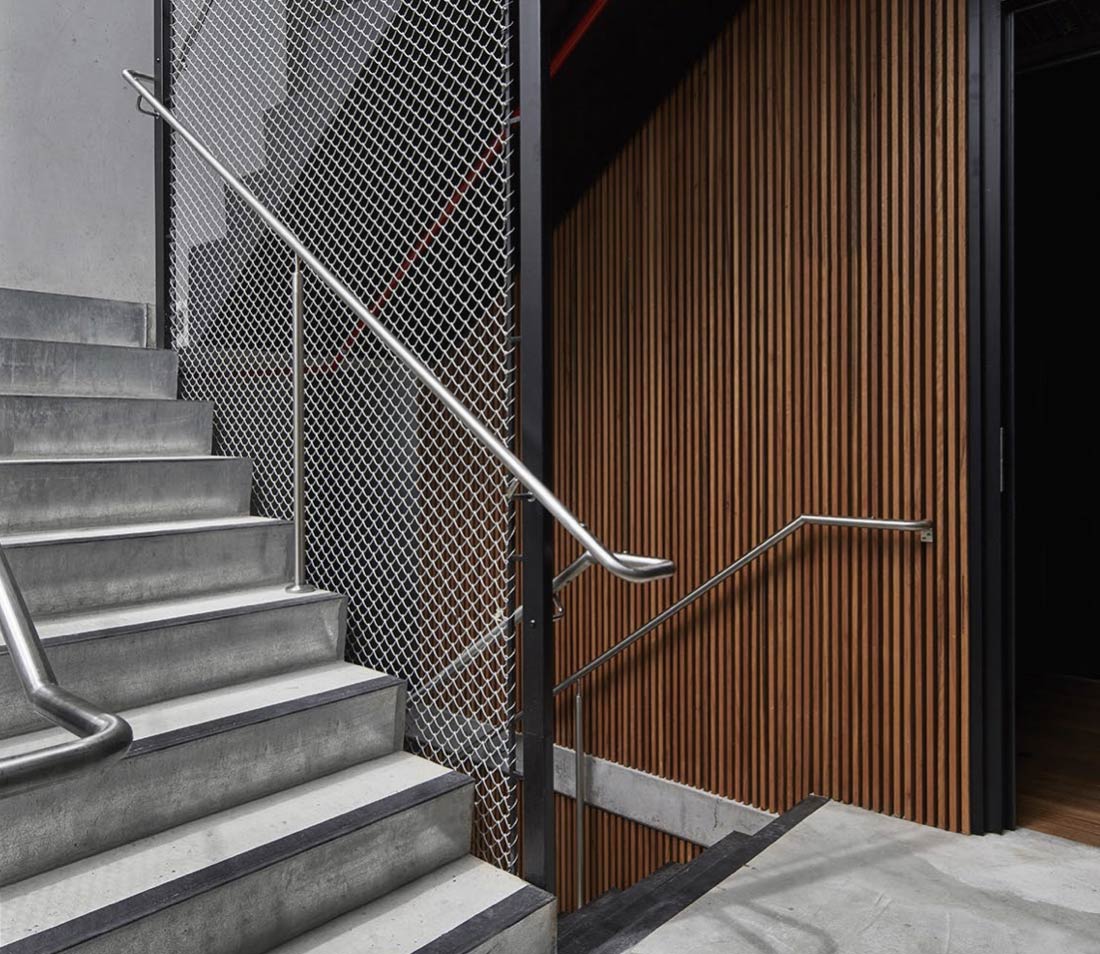
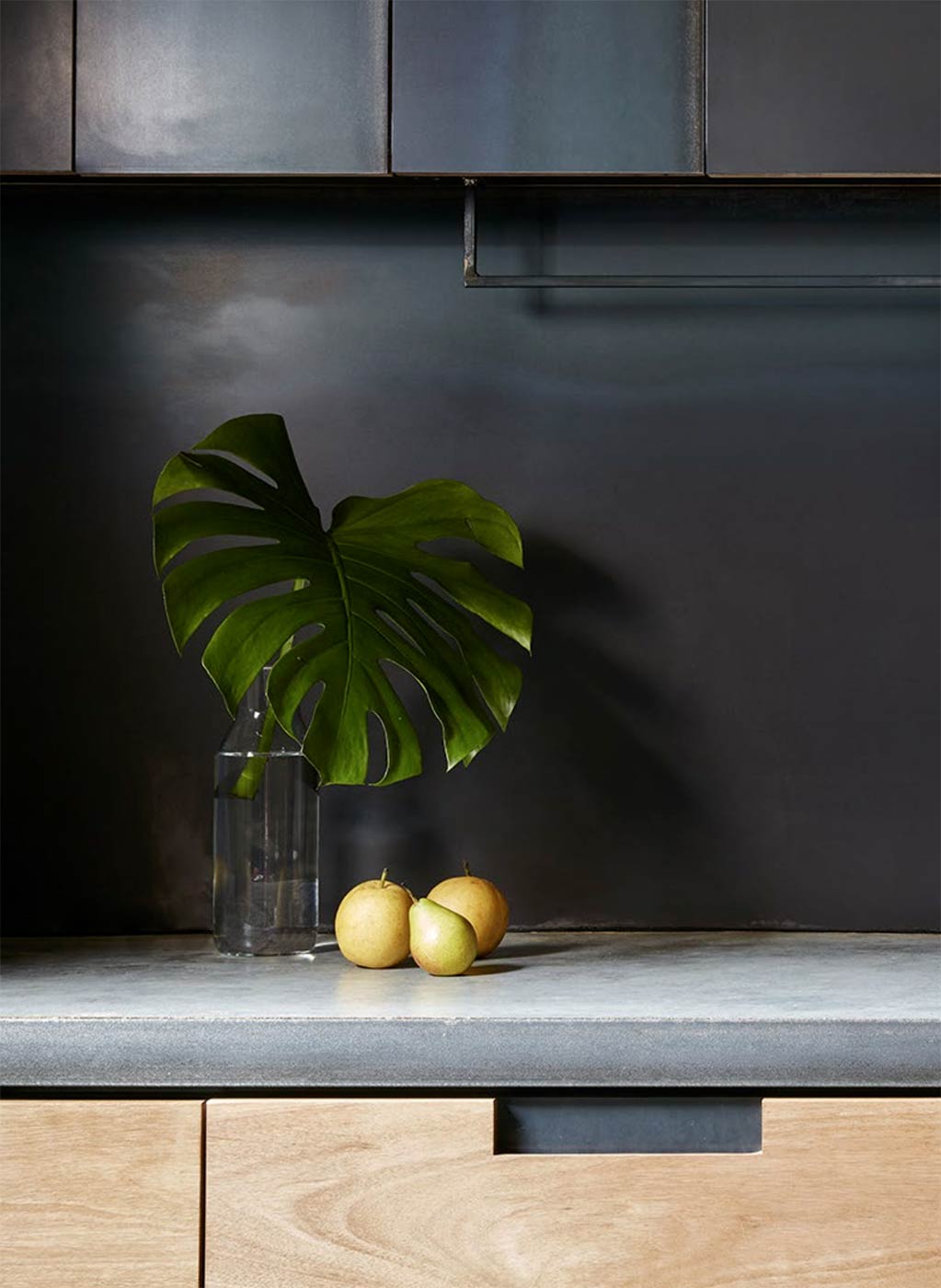
Concrete
Benchmarks
- Concrete to contain locally sourced recycled aggregates
- Concrete to contain minimum 30% fly ash or slag mix cement substitute where structurally viable
- Expose concrete where it is suitable to utilise thermal mass performance
- Provide thermal breaks (e.g. slab edges, balconies and glazing)
- Eliminate applied finishes over concrete that have no functionality
Exclusions
- Excessive use of concrete for pure aesthetic purposes
- Unfounded use of pigmented additives and decorative aggregates
Considerations
Concrete is composed of water, aggregate and cement. Cement is the binding agent in concrete and has high embodied energy due to it’s sourcing and manufacturing processes. Concrete has a high durability and a long life cycle that can be considered to offset the initial high embodied energy during production. Concrete has favourable properties to resist fire. It improves buildability, durability and acoustic and thermal performance. It can be used to serve as both structure and a finish. This multiplicity of qualities means that the use of concrete can reduce the need for additional layers and material skins.
The capabilities of concrete need to be weighed up against the energy impact of it’s material sourcing and the ongoing implications to the comfort and quality of the building. Where concrete can serve a number of purposes and reduce the need for additional structural or cladding layers, it can be considered a suitable material choice. Unnecessary applied finishes and the excessive use of concrete for aesthetic purposes should be avoided.
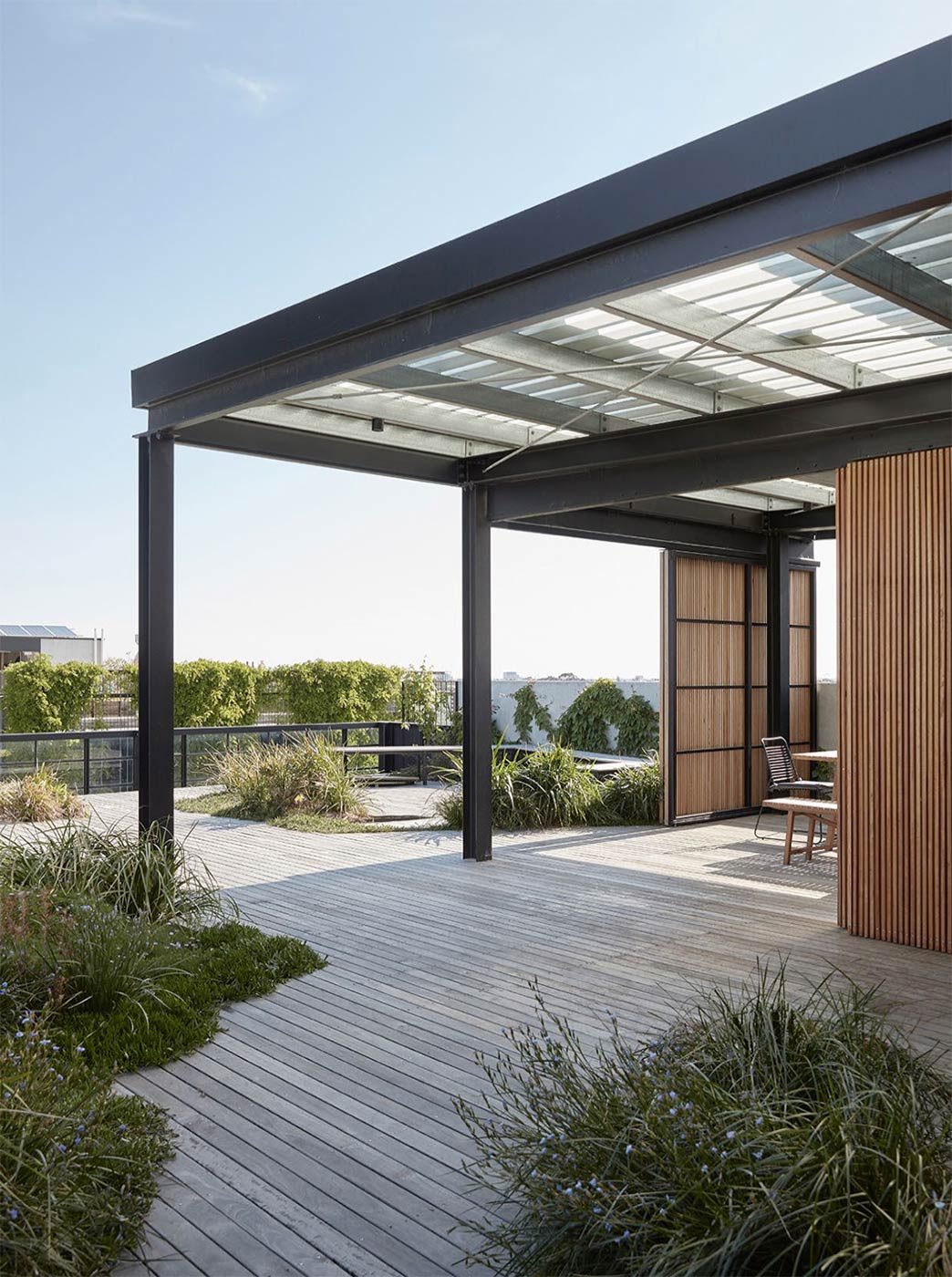
Roftop garden with timber decking at Nightingale 1
Timber
Benchmarks
- Prioritise the specification of timber in the following order: 1) Australian recycled timber, 2) Australian FSC & chain of custody certified timber, 3) Australian AFS & chain of custody certified timber
- Timber species to be specified appropriately according to their natural properties: Avoid the use of sealer finishes on class 1 & 2 timber in external areas (let the timber age naturally); avoid the use of class 1 & 2 timber in internal areas; avoid the use of class 3 & 4 timber in external areas
- Where possible, use mechanical fixings and avoid adhesives and finishes to reduce unnecessary maintenance and enable the timber to be reclaimed at the end of its life
- Prioritise quality timber window frames over aluminium where maintenance requirements allow.
Exclusions
- New timber sourced from non-FSC, PEFC or AFS accredited forests
- Any timber sourced from locations where responsible forestry cannot be assured
Considerations
Timber is one of the few renewable materials that contribute to the reduction of carbon emissions. Carbon from the atmosphere is taken and stored within timber during growth and makes up 40–50% of its gross weight. In addition to this the material has many environmental advantages:
- Naturally non-toxic and does not leak chemical vapor
- Versatile material able to be worked with simple equipment which can lead to reduced construction costs and energy consumption
- Natural insulator which can reduce energy needs when used in windows, doors and floors
- Timber can typically be sourced locally, is lightweight and uses relatively little energy to convert from the raw material to a building product in comparison to other structural materials such as steel and concrete
- Despite being a combustible material, timber is slow and predictable in the way that it burns which gives it natural fire performance capabilities
Conventional construction practice typically preference the use of adhesives to timbers in addition to mechanical fixings. Once glue-fixed, it is near impossible to reclaim or recycle timber at the end of the building’s life. Due to these implications where possible use only mechanical fixings to timber and design for disassembly.
We support the use of recycled and sustainably-sourced Australian plantation timbers throughout projects. Architects should understand the natural durability properties of timbers to ensure that it is specified and finished appropriately, as well as installed so that it can be reclaimed at the end of the building’s life.
Engineered timber
Benchmarks
- Prioritise locally manufactured products or those with a carbon neutral certification
- Prioritise products that are manufactured near to the location of the timber sourcing and processing
- All products must be low-VOC and NAF (no added formaldehyde) or Formaldehyde E0 where NAF is not practicable
Exclusions
- Products containing wood sourced from non-FSC, PEFC or AFS accredited forests
- Products containing timber, sourced from locations where responsible forestry cannot be assured
- Avoid products containing high concentrations of adhesives, as well as adhesive fixing methods
- MDF that does not have an E0 formaldehyde rating
- Products that expose the workers to toxic compounds through the cutting or working of the material
Considerations
Engineered timber products generally use derivative timber products with a binding agent to create a composite material that is more stable and economical.
This includes products such as plywood, MDF, densified wood, chemically-densified wood, fibreboard, particle board, oriented strand board (OSB), glue-laminated (glulam), laminated veneer (LVL), cross-laminated timber (CLT), parallel strand (PSL), laminated strand (LSL), orientated strand (OSL). Some of these products are the substrate to further products such as timber veneer boards and engineered floorboards.
The manufacturing process can provide many environmental advantages such as:
- Efficient use of a natural resource as smaller cuts or lower grade timber are processed to suit the application requirements of shape, strength and performance
- Stability and strength comparable to natural timber or steel
- Versatile materials able to be worked with simple equipment which can lead to reduced construction costs and energy consumption
- Veneer combined with a recycled substrate provides the aesthetic of timber without consuming as much virgin wood
Red flag issues surrounding many composite timber products include the additional energy resources to manufacture the product and the toxic and/or bio-accumulative emissions to the environment, along with VOCs that can impede upon the indoor environmental quality of finished spaces. Re-processing composite timber products is a possibility, however, the glues and other adhesives in the composition and fixing of composite timbers can hinder recyclability. Architects should assess selection of these products from a life-cycle and re-use perspective.
Treated timber
Benchmarks
- Choose timbers that are treated locally where possible
- Prioritise naturally resilient timbers over chemically treated timbers where possible
- Confirm that chemical timber treatments are approved by APVMA and ensure timber is treated within Australia
Exclusions
- Avoid timbers treated with Copper Chrome Arsenate (CCA)
Considerations
Treatments applied to timber can improve resilience to moisture, insects and rot. Treatments vary according to the intended performance of the timber and can be applied using chemicals, submersion, heat or radiation.
Chemical treatments: All timber preservative chemicals that are used in Australia must be approved by the Australian Pesticides and Veterinary Medicines Authority (APVMA) with quantities and concentrations determined by Australian Standards. Architects should be wary that timbers treated outside of Australia are not required to go through the same approval process and therefore may contain substances or concentrations deemed illicit. Though used within Australia, Copper Chrome Arsenate (CCA) treatments are known to leach heavy metals and carcinogenic materials into surrounding soils and groundwater. CCA timber should therefore be avoided. Safer treatments include Copper Quaternary (ACQ) and Copper Azole (CuAz). Architects should also interrogate the health and environmental implications of all insecticide treatments and avoid any treatment containing items on The Red List.
Accetylated wood: Acetylation is a non-toxic process where radiata pine is soaked in a vinegar-like organic compound known as acetic anhydride. Through this process, the timber is made resistant to rot, dimensionally stable and performs at class 1 durability. Accetylated wood is sourced and treated overseas and so the embodied energy of the material should be assessed against its benefits.
Naturally resilient timber: Architects should prioritise naturally resilient class 1 timbers in place of chemical treatments where practicable.
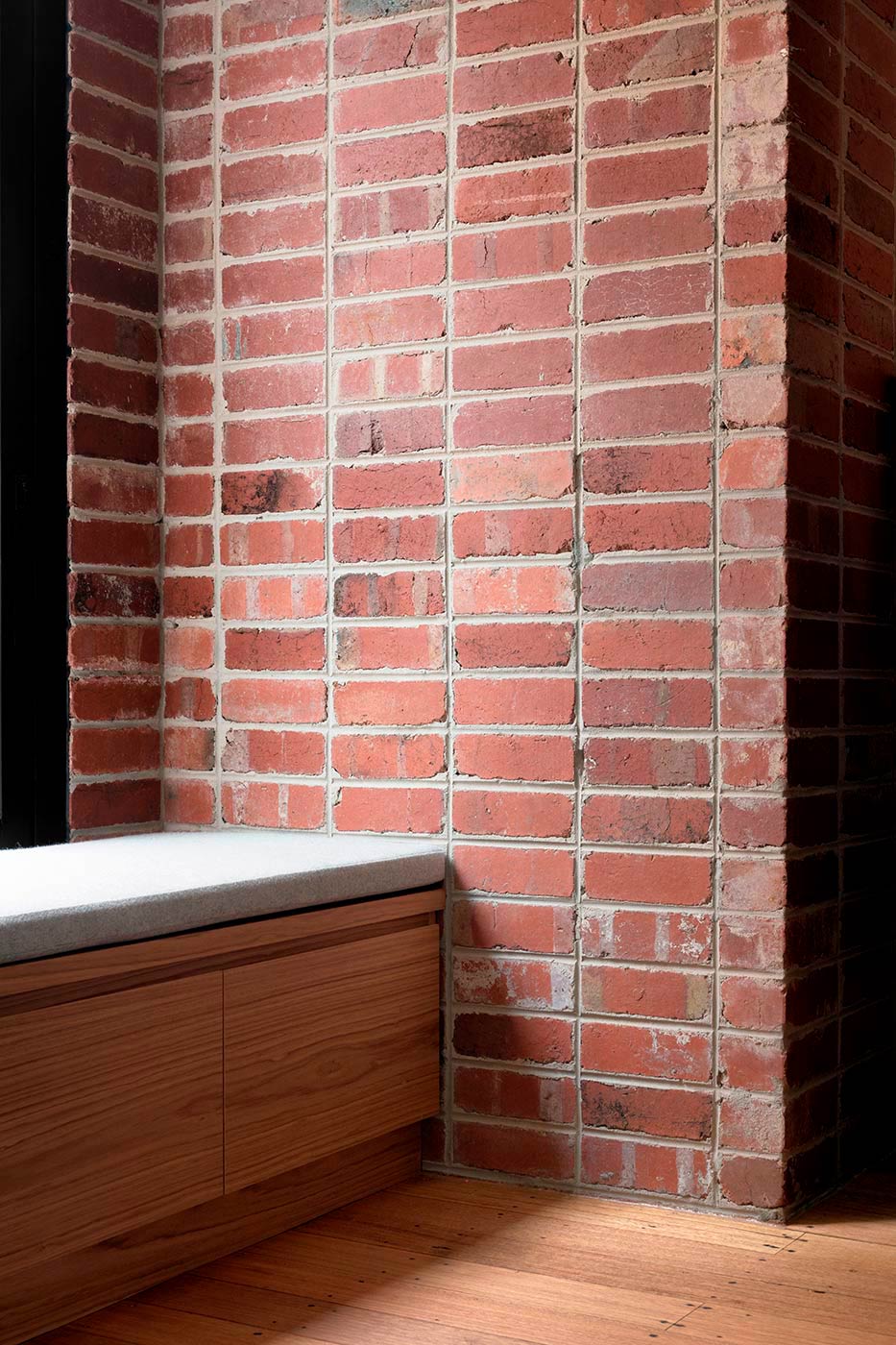
Brickwork detail at Brick and Gable House
Brick & blockwork
Benchmarks
- Prioritise the specification of bricks in the following order: 1) Locally sourced recycled bricks, 2) Australian-made carbon neutral bricks, 3) Australian-made bricks
- Prioritise the specification of blockwork with recycled content
- Design to reduce cutting and waste of bricks
- Specify safe working practices for the cutting of bricks and blocks (i.e. no dry cutting methods, use of respirators)
Exclusions
- Internationally imported bricks and blocks
- Unnecessary renders and applied finishes
Considerations
Bricks and blocks are durable and low maintenance masonry construction materials. They are high in thermal mass, possess good compressive strength and have weather-resistant, fire-resistant and acoustic insulation properties. Both bricks and blocks are inert materials and not prone to releasing VOCs. As with many masonry-based materials, bricks and blocks contain silica. Safe cutting and grinding practices must be employed to reduce the risk of severe health issues from crystalline silica inhalation.
Bricks are produced from kiln-fired natural clay and shale. Kiln-firing typically requires high natural gas consumption and so is high in embodied energy. Carbon-neutral bricks utilise biomass fuel (typically sawdust) in kiln-firing as a replacement to the burning of natural gas. These bricks are still made from virgin material so the use of locally sourced recycled brick is always preferred. In external wall applications, brickwork does not require an applied finish.
Blockwork has inherently high embodied energy due to its cement content, however, generally requires lower firing temperatures and less infrastructure than clay brick manufacture. Some manufacturers offer concrete block products that contain recycled aggregate or by-product replacements to cement, such as fly ash. These products should be prioritised where the use of blockwork is required. In some applications, blockwork requires additional applied finishes to ensure water tightness.
The durability and lifespan of masonry material should be weighed against their embodied energy. Where brickwork or blockwork can serve a number of purposes and reduce the need for additional structure or cladding layers, we identify it as a suitable material choice.
Wall cladding
Benchmarks
- When exposed to the elements, choose light-coloured claddings with high LRV (Light Reflectance Value)
- Use the material sheet size as a module where possible to reduce material waste
- Choose locally manufactured cladding materials
- Choose cladding based on waterproofing, durability, recyclability and low environmental impact
- Use durable wall claddings in high traffic areas
- Use low maintenance cladding systems in inaccessible areas
Exclusions
- No aluminium, composite aluminium or other composite claddings or those that contain polyethylene
- No combustible claddings
- No unnecessary applied finishes
Considerations
Fibre cement sheet cladding: Compressed fibre cement sheet is a composite material, formed with sand, cement and cellulose fibres. It is highly energy efficient, sturdy and contains fire-resistance properties, though typically requires applied paint finishes and so regular ongoing maintenance is required.
Timber claddings: See timber
Metal claddings: Sheet metal is durable and is typically recyclable at the building’s end of life. See metals and roofing for further discussion. Eliminate applied finishes where practicable.
Composite claddings: Composite cladding systems consist of two thin material sheets covering a core material, such as polyethylene. Due to the risks of flammability, composite panels, composite aluminium panels or those containing polyethylene must not be used.
Fixing methods: Internal and external cladding boards can be fixed with strapping as opposed to shadow-line joins to ensure water tightness and avoid destabilisation of joints due to UV exposure. This method also reduces the need for additional fixings, such as aluminium channels required in shadow-line jointing systems.
Location of material: The suitability of a cladding material to its location within the building must be considered. Materials that can be accessed from ground should be durable and responsive to the character and grain size of the neighbourhood. Materials in inaccessible areas should be low maintenance.
Shading: Cladding materials should respond to solar orientation, integrating shading, screening or double skin façades where appropriate. Architects must consider the accessibility and ongoing maintenance requirements of these elements and avoid outcomes that will require unrealistic upkeep.
Wall cladding should ensure high performance in fire resistance, waterproofing, acoustics, thermal insulation value and durability. Whilst many lightweight solutions will satisfy these requirements, exterior walls that contain thermal mass and require minimal finishes are predominantly better performing than lightweight alternatives.
Roofing
Benchmarks
- Choose roofing materials that can be recycled at the building’s end of life
- Choose roofing materials low in embodied energy
Exclusions
- Avoid dark-coloured roofs
Considerations
Roofing materials typically have a high embodied energy. They should be selected based on durability and maintenance, with consideration of roofing appropriate for the architectural form.
Steel roofing: Steel roofing is a lightweight, low maintenance and durable roofing material. It has a high embodied energy. This factor can be weighed against the longevity and recyclability of steel. Steel roofing is typically protected by galvanisation or coated with alloys. Galvanised steel is made resistant to corrosion after being immersed in molten zinc. Zincalume is an alloy-coated steel containing aluminium, zinc and silicon with high durability. Colorbond steel is pre-painted steel with a zincalume core.
Translucent roofing: Fibreglass roofing contains glass fibres, resins and other pigments. Though it is less energy-intensive to produce than steel, fibreglass roofing cannot be recycled at the end of its life. Polycarbonate roofing is made from strong plastics and can contain recycled content. It is resilient to extreme weather conditions and can be recycled at the end of the building’s life. Where specified, translucent roofing should be UV stabilised heavy-gauge quality.
Trafficable roofing: Trafficable roofing can be undertaken with a number of methods. Past roof terraces have employed a combination of exposed waterproofing screeds, decking and planted green roof areas. Green roofs work to reduce the urban heat island effect locally and serve as communal open spaces for residents. Intensive green roofs allow for deeper, more established planting whilst extensive green roofs are suited to shallow planting in less trafficable areas. The intended use of the rooftop areas should be weighed against the impacts of using intensive or extensive systems on the local conditions, project constraints and budget. Effective waterproofing is crucial in all cases of trafficable roofing.
Roof colour: Regardless of the material, choose roofs with low solar absorptance to reduce the heat load and the energy costs for cooling a building. Dark roofing colours should be avoided.
Plastics
Benchmarks
- Reduce or eliminate the use of plastic
- Specify recycled or recyclable plastic components
- Install plastic component so that they can be recycled at the buildings end of life
Exclusions
- Minimise the use of PVC (use recyclable metals, UPVC or HDPE for plumbing applications and cloth or LSZH-FR cabling in electrical applications)
- No plastic-coated or PVC containing floorings or linings
- Avoid products containing materials on The Red List
Considerations
Plastics are used extensively in conventional construction. The production of plastics causes extreme greenhouse gas emissions and is energy intensive in manufacture. Plastics are produced using non-renewable natural resources such as petroleum, coal and gas. They never break down and so perpetually pollute and degrade our land and waterways.
There is an increasing availability of building materials with recycled plastic content such as polyester thermal insulation batts that contain recycled PET plastics. These products should always be specified before alternatives that use new plastics. As the development of bioplastic construction material improves, architects should look to these as alternatives to conventional plastics.
Plastics should be reduced or eliminated where possible across all building materials and components. In particular, Polyvinyl Chloride (PVC) should be eliminated wherever possible due to its toxic content and hazardous impacts to the environment and humans during and at the end of life. Architects should be familiar with items on The Red List and avoid specifying products with listed ingredients wherever possible.
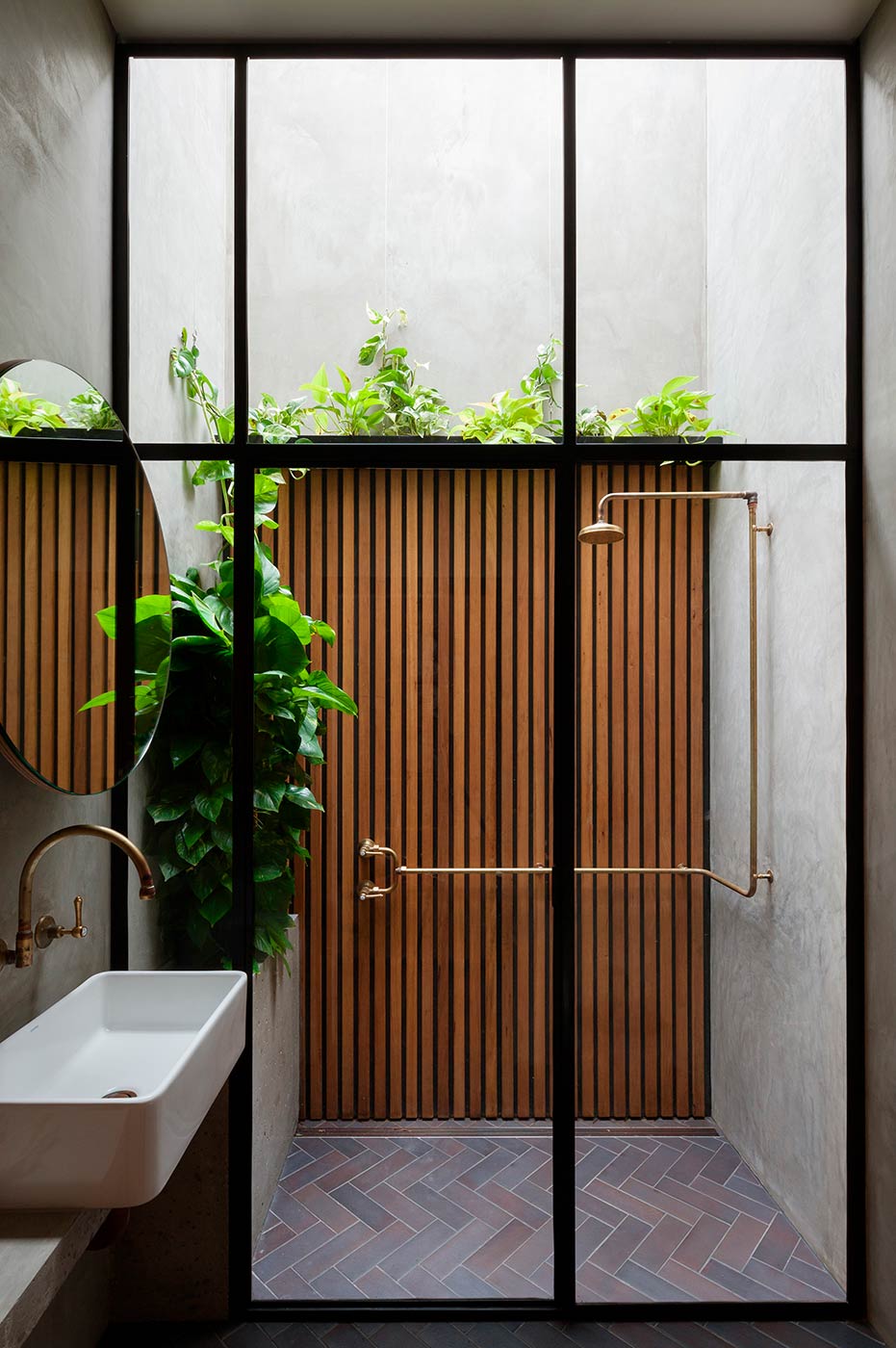
Bathroom fittings at Double Life House
Hardware & fittings
Benchmarks
- Choose Australian-made hardware and fittings where possible
- Choose fittings and hardware made of natural or raw materials that will age well (e.g. brass or stainless steel)
- Where applied finishes cannot be avoided, prioritise PVD finishes over electroplating
- Choose tapware within 1 WELS rating of the highest available water efficiency
Exclusions
- No chrome-plated hardware or fittings (see applied finishes)
- Eliminate applied finishes where possible
Considerations
Many hardware components are made with zinc, brass or stainless steel bodies that, conventionally, are treated with protective coatings. The manufacturing process from raw materials generally involves energy intensive casting and forging processes. In all cases, architects should understand the processes and environmental implications by which hardware is manufactured and finished.
Hardware and fittings should be a product of Australia or made in Australia where available. Care should be taken to specify hardware that is made of robust natural or raw materials that last the lifetime of the building and can be reclaimed. Architects should assess whether hardware or fittings can be eliminated or made more efficient and less material intensive. Applied finishes should be eliminated or reduced.
Plasterboard
Benchmarks
- Eliminate the superfluous use of plasterboard
- Prioritise use of plasterboard with recycled content and recycled lining paper
- Prioritise use of carbon neutral plasterboard
- Specify moisture resistant plasterboard with a non-toxic, anti-fungal agent to resist mould growth in wet areas
- All plasterboard products should be low-VOC
- Design to reduce on-site waste and improve recyclability
Exclusions
- Use of plasterboard in areas prone to flooding
- Use of plasterboard in high traffic areas which will require rigorous ongoing maintenance
- Use of plastic plastering beads
Considerations
Plasterboard is comprised of a gypsum core with paper facing. Gypsum (hydrated calcium sulphate) is a natural by-product of evaporated lake and sea water. Natural gas is used to heat the Gypsum at high temperatures to cause calcination, then mixed with water and poured over the paper facing. Substances can be added into the mix to improve performance against moisture and mould, fire and acoustic sound transmission.
Plasterboard is extensively used as wall and ceiling lining in conventional construction. Though a non-toxic material, plasterboard still contains VOCs and requires fossil fuels to be burnt during its production. The gypsum in plasterboard can be reclaimed at the end of its life and made into new products though due to labour costs in disassembly, plasterboard is often sent to landfill.
As plasterboard is surface lining, architects should question whether raw structural walls and ceilings can be exposed, eliminating the need for plasterboard. Where plasterboard is used, architects must assess how to reduce on-site wastage by incorporating available sheet sizes and specifying fixing systems that increase ease of recyclability. Plasterboard should be low VOC to reduce impacts on indoor air quality.
Tiling & paving
Benchmarks
- Minimise the use of tiles and engineered stone
- Where used, prioritise Australian-made tiles with recycled content
- Select flooring and paving styles that will exceed trends throughout the life of the building
- Prioritise stone sourced locally or available elsewhere in Australia
- Specify safe working practices for the cutting of stone (i.e. no dry cutting methods, use of respirators)
Exclusions
- No stone sourced from unethical quarries
- Tiles sourced from anywhere that environmental and ethical manufacturing practices are not acceptable or cannot be guaranteed
- Avoid stone or engineered stones with high silica content
- No dry cutting, grinding or polishing of engineered stone
Considerations
Tiles: Tiles are robust floor and wall coverings that are durable over the life of a building. Tiles are typically made from raw clay minerals that are crushed into small particles. The particles are further ground, mixed and processed before being glazed and then fired. This energy-intensive process produces greenhouse gases, pollutants and large amounts of wastewater. Adhesives and grouts that are used to install tiles can contain VOCs and reduce recyclability. In many cases, tiles are replaced before they reach the end of their useful life due to poor installation or because their style is no longer appreciated. When the application is appropriate, choose tiles that have recycled content and select a style that will likely endure the life of the building. Locally made tiles should be prioritised, however, there are very few tiles that are manufactured in Australia. When specifying tiles manufactured overseas, choose those with proven sustainable manufacturing processes and fair work practices. It is imperative that architects understand where raw materials are sourced, where manufacturing occurs and the associated embodied energy in these processes and transportation. As tiles are applied as a finishing layer, architects should interrogate whether tiles should be used within the project at all.
Terrazzo: Terrazzo is a highly durable material that is comprised of natural stone aggregates, recycled glass or plastics held together with cement or epoxy binders. Terrazzo can be laid in situ or as tiles. Stone aggregates can be sourced as offcuts from quarry processing, though these are generally imported from overseas. Architects should choose terrazzo that is Australian made from Australian materials which contain no plastics or epoxy binders.
Stone: Stone paving is a natural and durable material that can be recycled at the building’s end of life. Some stones have higher crystalline silica content than others (e.g. sandstone). Safe cutting processes must be undertaken to prevent the risk of silicosis disease. Stone should only be specified where it can be locally sourced, using ethical quarrying processes. Architects should understand the durability and suitability of the specified stone for its purpose and consider ongoing maintenance. See adhesives and sealants for guidelines on stone sealants.
Engineered stone: Engineered stone is made of natural stone and resins. Quartz-rich engineered stone contains over 90% crystalline silica content. Where safe work practices are not undertaken, there is a substantial risk of silicosis and other illnesses to those involved in manufacture and cutting processes. Due to these health risks, engineered stone with high silica content should be avoided.
See adhesives and sealants for specification principles on sealers and grouts.
Applied finishes
Benchmarks
- Low/zero VOC products where practicable
- Eliminate unnecessary finishes
- Avoid finishing treatments to exposed class 1 and class 2 timbers
- Choose finishes that are fit-for-purpose
Exclusions
- No chrome finishes
Considerations
Applied finishes should be reduced or eliminated throughout the project wherever practicable. This methodology encourages the specification of materials that require no finish to maintain their integrity.
Chrome-plating: A common coating to metals, this substance is highly energy intensive to apply and a known human carcinogen and corrosive dangerous good. Due to these hazards, chrome-plated hardware and fittings must not be specified.
Other metal coatings: Other metal coatings include powder-coating, electroplating, anodising and Physical Vapour Deposition (PVD). These processes vary in physical appearance and performance capabilities of the coated product. Similarly, the coating processes vary in the use of energy, production of waste and use of harmful chemicals. Generally, PVD coating represents the lowest environmental impact. Architects should assess whether natural finishes can be maintained before exploring other metal coating solutions.
Paint: Paint is typically made up of pigment, resin, solvent and additives. Paint can be toxic to humans and the environment. Conventional paint is a key source of indoor air pollution and releases VOCs that are detrimental to the ozone layer and human skin and respiratory systems. Only ultra low-VOC paints (<1g/L) should be specified as broad wall paints, particularly in internal areas. Some specialty paints and protective coatings require higher chemical content to ensure durability, in these cases, low-VOC options should be specified where practicable.
Timber finishes: Exposed class 1 and class 2 timbers should be left untreated to naturally ‘grey off’. This minimises applied finishes and reduces ongoing maintenance to the timber. An initial application of protective oil may be required to stabilise timber during construction, however, should not be intended as a finished treatment. Architects should note that under initial exposure, the tannins in untreated timber will naturally leach onto adjacent surfaces during this process. Where finishes are applied to timber (e.g. floor boards and bench tops), they should contain natural materials, be low-VOC, UV stable and not compromise the recyclability of the material at the end of its useful life.
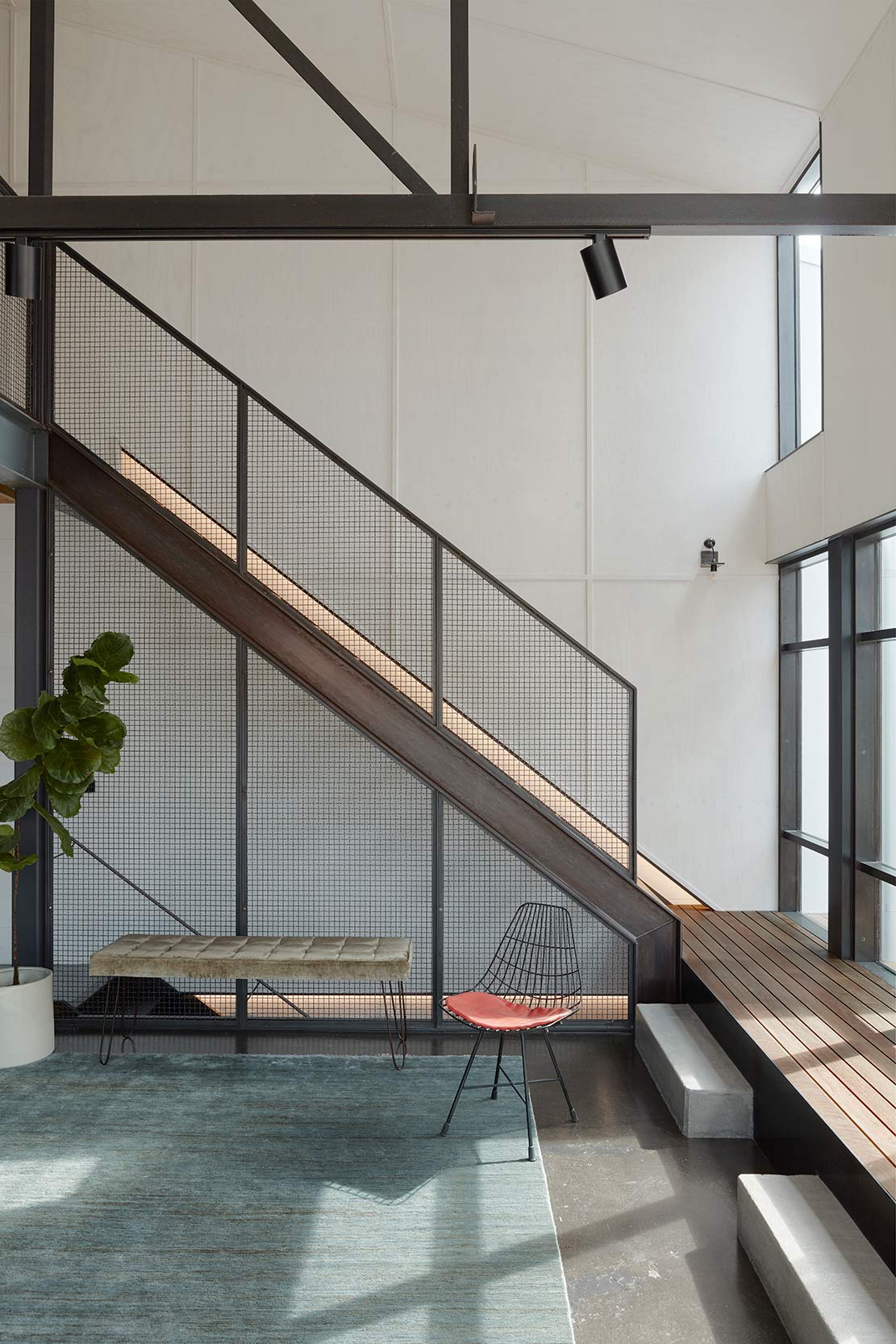
Mild steel staircase, framing and balustrade in Warehouse Greenhouse
Metals
Benchmarks
- Choose metals that do not require a finish
- Use recycled and/or recyclable metals
- Reserve the use of aluminium for external applications
Exclusions
- Eliminate the superfluous use of aluminium
Considerations
Metals should be selected for their durability and impacts on sustainability. Most metals require intensive energy-use in mining and production. As such, they should be used responsibly throughout projects. Metals that do not require a finish are preferred, ensuring natural and lower embodied-energy solutions. The ‘perfectly-imperfect’ quality of metals that patina over time should be embraced and communicated to end users.
Black mild steel: Mild steel is the most common form of steel and is flexible, high in tensile strength and economical. It is composed of carbon, manganese, silicon and other elements and can be fully recycled. In its raw form, mild steel is highly corrosive. With a suitable protective coating, mild steel is suited to structural uses, internal components, joinery and fixtures.
Galvanised steel: Hot dipped galvanised steel involves the coating of the metal with zinc to protect the inner core from corrosion. Like other metals, it is fully recyclable. There are environmental risks in the galvanising process with manufacturing areas prone to zinc infiltration to soil and drinking water. The use of galvanised steel should be applied rationally.
Aluminium: Lighter than steel and 100% recyclable, aluminium is highly corrosion-resistant. Due to manufacturing process aluminium is high in embodied energy, utilising over 9 times the amount of energy in its making than steel. The use of aluminium should be reserved for external applications where its corrosion resistance properties are required. The use of aluminium in interior applications should be avoided.
Copper: Also a highly recyclable material which retains its quality when reprocessed, copper is a hard-wearing and anti-bacterial metal that will patina over time with exposure and use. Copper can be applied for plumbing and wiring applications with further uses (e.g. cladding, hardware) assessed with the financial goals of the project in mind.
Brass: Brass is an alloy made from copper and zinc that can be infinitely recycled. It is durable, and like its parent material copper, will develop a natural patina with time and use. When reclaimed, brass retains a high value which increases the likelihood that the material components will be recycled at the end of the building’s life. Brass is the body material to most tapware and door hardware. With no need for an applied finish, brass in its raw state is a great choice for hardware and tapware.
For more on stainless steel see joinery.
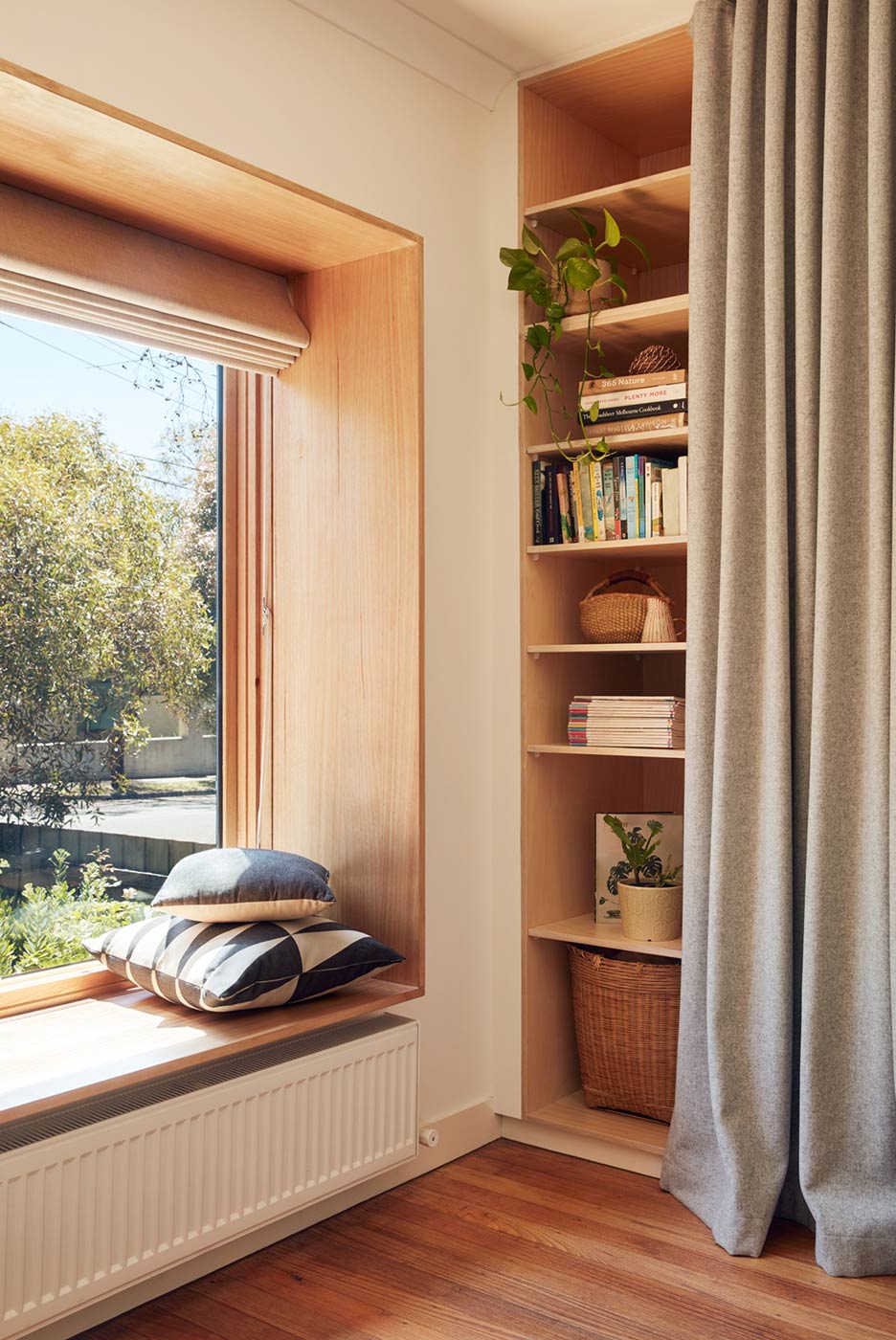
The use of timber for joinery and the window box at Inside Out House
Joinery
Benchmarks
- Low/zero VOC products
- No added formaldehyde or E0 formaldehyde products
- Choose joinery materials local to the location of joinery fabrication
- Prioritise products with recycled content or those that are recyclable
- Prioritise mechanical fixings to improve recyclability
Exclusions
- Stone from unsustainable sources
- Avoid stone or engineered stones with high silica content
- No dry cutting, grinding or polishing of engineered stone
Considerations
Joinery is subject to frequent usage and handling. Selections should prioritise natural, durable joinery materials that exceed trends.
Solid timber: Solid timber bench tops and joinery are a durable and renewable material source. See timber and adhesives & sealants for principles on specification. Architects should design timber joinery to minimise waste and maximise the recyclability of the material at the building’s end of life.
Plywood, MDF and particle board: Plywood, MDF and particle board are common joinery board substrates. Many joinery boards can be used in their raw form and simply be sealed with a clear, low-VOC finish where required. This eliminates the need for a decorative layer such as laminate, which cannot be repaired over time. Finger pulls or handles can also be routed into the material, eliminating the need for additional joinery furniture. See engineered timber for more information.
Laminates: Laminate is composed of layers of paper that are impregnated with resins, then compressed under pressure and heat. Architects should ensure that paper content is FSC-certified and that all resins are water-based where practicable. Low pressure laminates are decorative and made to be bound to a MDF or particle board substrate. See engineered timber.
Natural stone: Though more costly than some other options, natural stone can be incorporated as a durable benchtop option. Stone should only be sought from quarries with sustainable and ethical practices. Architects should select stone from local quarries where available to reduce the embodied energy in importing processes. Stone elements should be designed to be reclaimed at the end of the buildings life.
Engineered stone: Engineered stone is made of crushed natural stone and resins. It is durable, non-porous and scratch resistant making it a well-performing benchtop material. The high quartz content leads to substantial risk of silicosis and other illnesses if safe work practices are not undertaken. Due to these health risks, engineered stone with high silica (quartz) content should be avoided.
Stainless steel: Though high in embodied energy, stainless steel is an extremely durable, fully recyclable material. An outer layer of chromium oxide enables corrosion resistance that improves the performance of stainless steel. The chromium content poses risk only in the form of fumes produced during welding. Architects should reduce or eliminate the need for welding and ensure that the material can be reclaimed at the end of its useful life.
Carpet & flooring
Benchmarks
- Low/zero VOC floorings and underlays with E0 or E1 formaldehyde ratings
- Use floorings with natural and recycled content and/or floorings that can be recycled.
- Design to reduce on-site waste
- Reduce the use of adhesives and design for disassembly
- Choose flooring that is fit-for-purpose
Exclusions
- Minimise the use of carpet
- No PVC-based flooring (e.g. vinyl)
- Eliminate the use of flooring that artificially replicates the appearance of a natural material (e.g. timber- or stone-look flooring)
Considerations
Architects should first consider whether carpet and other flooring is required over the structural substrate. The flooring specified should take into account the material content, recyclability, durability and maintenance requirements.
Timber: Refer to timber and engineered timber
Laminates: See engineered timber
Carpet: Fabrication, wastage and maintenance are the key factors in specifying carpet. Carpet has a relatively short lifespan and cannot be reconditioned like other floor materials can. Where synthetic and natural fibres are combined, recycling of some carpets can be difficult. Avoid carpets in projects where more durable alternatives such as timber flooring are available. When specified, architects should choose carpets with renewable content (e.g. sisal and wool, see textiles) or recycled content, and investigate the embodied energy and any chemical treatments applied to the carpet.
Concrete: See concrete
Cork: Cork is a non-toxic, recyclable and renewable resource with a low embodied energy production. Cork is harvested from the bark of cork oak tree. Though they are slow growing, the trees are not damaged by the harvesting processes and can live to be 300 years old. Cork is largely grown and manufactured overseas, so the value of the product should be weighed against the embodied energy impacts of import. Where applied, architects must specify non-toxic cork with zero or low-VOC sealers.
Linoleum: Linoleum is made from natural raw materials, is non-toxic and biodegradable, however, can be linked to significant methane emissions from linseed crop production. Linoleum is typically installed using adhesives which can reduce the potential for the material to be re-purposed at the end of the building’s life. Where applied, architects should design to reduce on-site wastage of linoleum, specify mechanical fixing methods where suitable or otherwise ensure that non-toxic adhesives are used.
Recycled rubber: Recycled rubber flooring utilises waste rubber to form a durable, and sound-absorbing floor covering. It does cause minor off-gassing and so should be specified for a well-ventilated context. Where applied, architects must specify non-toxic, low-VOC adhesives and sealers and design for minimal on-site waste.
Vinyl: Vinyl flooring is made from polyvinyl chloride (PVC). Depending on the manufacturing processes, vinyl can contain dioxins and carcinogenic toxins as well as harmful plasticisers. If it catches alight, vinyl can release toxic fumes. Therefore, the use of vinyl flooring should be eliminated.
Textiles
Benchmarks
- Natural, locally sourced textiles wherever possible
- Specify fabrics with recycled content
- Specify untreated fabrics or those with natural dyes
- Request chain of custody information on textile materials and ensure ethical and environmentally responsible practices
- Design removable covers for upholstery to allow fabric to be maintained over the building’s life
Exclusions
- Eliminate protein fibres; wool, silk, mohair and cashmere unless ethical and environmental chain of custody processes can be proven
- Reduce polyester and vinyl, unless containing recycled content and eliminate PVC where possible
- No fuse-fixed linings to fabrics, instead sew-fix all linings to improve recyclability
Considerations
Many textile products require intensive manufacturing processes. Architects should eliminate unnecessary textile finishes and specify low-impact, long-lasting fabrics that exceed trends.
Wool: Wool is durable and breathable textile that naturally biodegrades and is zero-VOC. As with other animal agricultural processes, wool farming results in significant methane and greenhouse gas emissions. Wool production is land intensive, causes erosion and loss of local biodiversity. Due to these issues, wool should only be sourced from suppliers with proven ethical and environmentally responsible processes.
Cotton: Cotton is a light, breathable, zero-VOC textile that is biodegradable. Cotton production uses large amounts of water for irrigation and in turn, can salinise soil and deplete local water resources. Conventional cotton production utilises large amount of harmful pesticides and fertilisers. Cotton should be organic, sourced from local plantations and must include recycled content.
Linen: Linen is breathable and, when untreated, biodegrades naturally and is zero-VOC. It is made from flax crop, which uses much less water and pesticides to produce than cotton crops. Flax crops are mostly located overseas and so the embodied energy of the crop should be considered. Linen should be organic, sourced as locally as possible and untreated with dyes that prevent its ability to biodegrade.
Hemp: Hemp is a low-impact fabric made from the natural fibres of the hemp plant. It has a high yield per hectare due to the density of the plant, meaning it requires less land to grow on. It also requires no herbicides and very little water to grow (one quarter of the water required to produce cotton). Organic, locally grown hemp should be considered as alternative to other water-intensive textiles.
Polyester, PVC and vinyl: Polyester and vinyl are synthetic plastic textiles derived from petroleum. They do not biodegrade and contain dyes that are toxic to textile workers and the local environment surrounding manufacture. Only non-toxic polyesters, PVC and vinyls with high recycled content should be specified for textile applications.
Leather: Like wool, the leather industry has damaging environmental impacts during farming and production. Leather workers and local ecology are exposed to high quantities of hazardous chemicals during processing. The use of leather should be eliminated.
Silk: Though a natural and renewable textile resource, conventional silk production is a highly unethical practice. Silk should be eliminated.
Adhesives & sealants
Benchmarks
- Low/zero VOC and formaldehyde E0 or E1 products
- UV stable products
- Avoid the use of adhesives to increase recyclability of materials at the building’s end of life
Exclusions
- Avoid products containing materials on The Red List
- Products containing carcinogenic materials or toxic heavy metals
Considerations
Adhesives and sealants can have major impact on human health and indoor air quality. Many conventional adhesives and sealants contain toxic ingredients such as silica, residual monomers, plasticisers and heavy metals and have significant VOC emissions. In addition, many other ingredients require high energy use and produce harmful emissions and toxins during production.
The use of adhesives should be minimised to increase the likelihood for building materials to be recycled at the building’s end of life. Mechanical fixing is always preferred over adhesive use. Architects should interrogate the material content of specified adhesives and sealants and ensure that products containing ingredients on The Red List are avoided or eliminated. Refer to the product Green Star rating and GECA certification as a standard.
Insulation
Benchmarks
- Specify high-performance insulation with maximum recycled content
- Detail for continuity of insulation
- If in doubt, check product Green Star ratings or use GECA certified products
Exclusions
- Reduce the use of non-recyclable insulation
- Avoid or eliminate insulation containing formaldehyde binders
- No CFC containing rigid foam insulation
Considerations
Insulation is crucial to building performance. The source, content and environmental impacts of insulation, as well as the net energy balance over its life must be investigated (i.e. Will the insulation save more energy than is used to produce it?)
High performance and environmentally-friendly insulation with maximum recycled content should be specified wherever possible. Gaps in insulation material have major implications on material performance. Architectural detailing and site instruction must ensure that insulation is installed continuously so that the material system is not wasted.
Specification should preference insulation materials with safe handling for installers and weigh the cost of the product in the scheme of the project against financial goals.
Batt insulation: Batt insulation is formed from a variety of materials, including mineral wool, fibreglass, polyester and wool. Most of these materials contain recycled content with varying embodied energy requirements and environmental impacts, both during production and in disposal. Batt insulation should be non-flammable, moisture/vermin resistant and be without added chemicals such as formaldehyde-based binders where possible.
Rigid foam insulation: Rigid foam insulation generally comes as EPS (expanded polystyrene) or XPS (extruded polystyrene). Whilst they are high-performing products of efficient thickness, both EPS and XPS are greenhouse gas intensive in production (depending on blowing agents) and not easily recyclable. Due to flammability risks, the use of EPS within multi-level buildings is prohibited. Certified CFC-free (CO2 blown) rigid foam insulation should always be specified where available.
Blown-in/spray-on insulation: Cellulose fibre is a renewable and low embodied energy insulation material made from 100% post-consumer waste newspaper. To improve its suitability as a cavity insulation, cellulose can be treated with anti-flammability and termite resisting coatings made from natural borates. Concerns around the inhalation of particles suggest safe installation to a well-sealed cavity is critical. Where appropriate to the application, cellulose insulation is a favourable option for insulation.
Further Reading
We're collating a growing list of suppliers of sustainable materials and services that Breathe is working with on a regular basis in our Suppliers Directory.
- The Red List — International Living Future Institute
- Declare Products — International Living Future Institute
- EcoSpecifier Priority Guides — EcoSpecifier Global
- GreenSpec — Building Materials Impacts
- GECA Standards Lists — Good Environmental Choice Australia


